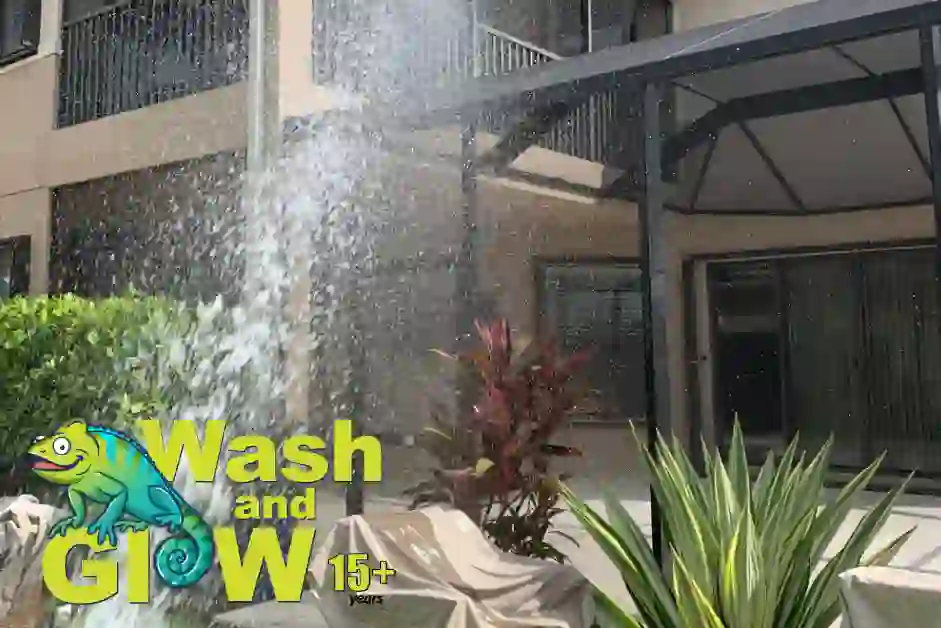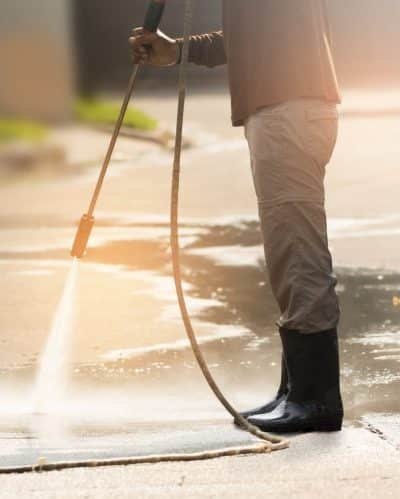Maintaining your patio’s cleanliness is essential for preserving its appearance and longevity. Over time, patios accumulate dirt, grime, mold, algae, and other debris that not only make them unsightly but can also cause structural damage. Power washing, also referred to as pressure washing, is one of the most effective ways to clean your patio and restore its original beauty.
Patio power washing is not merely about aesthetics; it plays a vital role in improving the safety of outdoor spaces. Slippery algae and mildew buildup can create hazardous conditions, especially in areas prone to moisture. Furthermore, regular cleaning can prevent costly repairs by addressing stains and damage early. Whether you’re tackling a concrete, stone, paver, or wooden patio, power washing can rejuvenate your outdoor area efficiently.
In this article, we’ll explore everything you need to know about patio power washing. From its benefits and the best tools to how to handle stubborn stains and choose the right settings, we’ll cover every aspect. By the end, you’ll have the confidence and knowledge to transform your patio into a spotless, inviting space.
The Benefits of Patio Power Washing
Restoring Aesthetic Appeal
A clean patio significantly enhances the appearance of your entire outdoor space. Dirt, mold, and algae can dull the surface over time, making it look older than it is. Power washing removes these contaminants, revealing the vibrant texture and color of the original material. Whether you’re preparing for an outdoor gathering or boosting curb appeal, this process is key.
In addition to visual improvements, power washing can help remove unsightly stains caused by grease, rust, or plant debris. These stains can be difficult to remove manually but are no match for the high-pressure water stream of a power washer.
Preventing Structural Damage
Beyond improving appearances, power washing protects your patio from long-term damage. Mold and mildew, if left unchecked, can weaken wood, stone, and concrete over time. Algae buildup can even penetrate surfaces, causing cracks and erosion in the material.
Regular power washing keeps the patio’s surface intact by clearing out organic materials that trap moisture. This prevents structural wear and tear, saving you money on repairs or replacements in the long run.
Improving Safety
Safety is another important benefit of patio power washing. Algae, mold, and mildew can make surfaces slippery, increasing the risk of slips and falls. This is especially concerning for households with children or elderly individuals.
Using a power washer to clear these hazards creates a safer environment for everyone. Furthermore, it reduces the potential for allergen buildup, such as pollen and dust, that may trigger respiratory issues for some people.
Essential Tools and Equipment for Power Washing Patios
Choosing the Right Power Washer
The type of power washer you choose depends on your patio material and cleaning needs. For most residential patios, an electric power washer with 1,500 to 2,000 PSI (pounds per square inch) is sufficient. This level of pressure effectively removes dirt and stains without damaging the surface.
For tougher cleaning jobs or larger patios, a gas-powered washer with higher PSI may be necessary. These models provide more power but require extra care to avoid harming delicate materials like wood or softer stones.
Nozzles and Spray Patterns
Nozzles play a crucial role in determining the effectiveness of your power washing. Different nozzles produce varying spray angles, ranging from a narrow jet for tough stains to a wider fan for general cleaning. The most common nozzle types include:
- Red (0 degrees): High-pressure jet for spot cleaning stubborn grime.
- Yellow (15 degrees): Ideal for removing dirt from concrete and stone.
- Green (25 degrees): Best for general cleaning tasks on various surfaces.
- White (40 degrees): Gentle cleaning for delicate materials like wood.
Always test the nozzle on a small, inconspicuous area to ensure it won’t damage your patio surface.
Cleaning Solutions and Detergents
For patios with heavy staining or mold growth, adding a detergent or cleaning solution to your power washer can make a significant difference. Look for biodegradable cleaners that are safe for plants and surrounding areas.
Common patio cleaning solutions target specific issues, such as mold, grease, or rust. Apply the solution to the surface, let it sit for a few minutes, then rinse thoroughly with the power washer for optimal results.
Preparing Your Patio for Power Washing
Clearing and Protecting Surrounding Areas
Before power washing, remove all furniture, decorations, and potted plants from the patio. Cover nearby landscaping, such as flower beds or grass, with plastic sheeting to protect them from high-pressure water and cleaning solutions.
Take precautions to shield walls, windows, and doors from potential spray-back. Using painter’s tape to secure protective coverings is a simple yet effective way to prevent accidental damage.
Inspecting the Patio Surface
Inspect the patio surface carefully for cracks, loose pavers, or other structural issues before power washing. High-pressure water can exacerbate existing problems, so repairing these issues beforehand is crucial.
For wooden patios, look for signs of rotting or splintering. For concrete or paver patios, check for loose joints or gaps that might need resealing after the cleaning process.
Pre-Treating Stains and Grime
Some stains, such as grease, oil, or mold, require pre-treatment before power washing. Apply an appropriate cleaning solution to these areas and let it soak in for at least 10-15 minutes. Use a scrub brush to loosen stubborn grime if necessary.
Pre-treating stains ensures the power washer can remove them more effectively and reduces the risk of streaks or uneven cleaning.
Proper Techniques for Power Washing a Patio
Adjusting Pressure Settings
Selecting the right pressure setting is critical to avoid damaging your patio. For durable materials like concrete, higher pressure settings (2,000-3,000 PSI) are safe. However, for softer materials like wood or composite decking, stick to lower settings (1,000-1,500 PSI) to prevent splintering or gouging.
Always start with the lowest pressure and gradually increase if needed. Keep the spray nozzle at a consistent distance of 12-18 inches from the surface to achieve even cleaning.
Working in Sections
To ensure thorough cleaning, divide the patio into manageable sections. Start at one end and work systematically across the space, overlapping each pass slightly to avoid streaks. Work in straight, even strokes for the best results.
Pay extra attention to corners and edges where dirt tends to accumulate. For particularly dirty areas, use a scrub brush or a rotary surface cleaner attachment for better results.
Rinsing and Drying
After completing the power washing, thoroughly rinse the entire patio with clean water to remove any remaining detergent or debris. Let the patio air dry completely before returning furniture or decorations to avoid trapping moisture.
For wooden patios, consider applying a sealant after drying to protect the surface and extend its lifespan. This step is particularly important if the patio is exposed to frequent rain or harsh sunlight.
Troubleshooting Common Power Washing Challenges
Removing Stubborn Stains
Even with a power washer, some stains may require extra effort. For rust or oil stains, use a specialized cleaner designed for those issues. Apply it directly to the stain and scrub with a stiff-bristle brush before rinsing.
For organic stains like mold or algae, bleach-based cleaners can be effective. Just ensure the solution is diluted and safe for the surrounding environment.
Avoiding Surface Damage
Using the wrong pressure setting or nozzle can cause surface damage. Always test the equipment on a small area first and follow the manufacturer’s recommendations for your patio material.
For painted or sealed surfaces, avoid high pressure or abrasive detergents, as they can strip coatings and require costly repairs.
Dealing with Equipment Issues
If your power washer isn’t performing as expected, check the nozzle and filter for blockages. Regular maintenance, such as cleaning the pump and hoses, ensures consistent performance. Refer to the user manual for troubleshooting specific issues.
FAQs
How often should I power wash my patio?
The frequency of power washing depends on your location and climate. In most cases, once or twice a year is sufficient. However, areas with heavy rainfall, high humidity, or frequent foot traffic may require more frequent cleaning.
Can I power wash a patio myself, or should I hire a professional?
Power washing a patio can be a DIY task with the right tools and precautions. However, if your patio has extensive stains or damage, or if you’re unsure about using the equipment, hiring a professional is recommended for the best results.
Is power washing safe for all patio materials?
Not all materials are equally suited for high-pressure cleaning. Concrete and stone can handle higher pressure, but wood and composite decking require lower settings to avoid damage. Always check the manufacturer’s guidelines for your patio material.
What is the difference between power washing and pressure washing?
Power washing uses heated water, which is more effective at removing grease and tough stains. Pressure washing uses cold water and relies solely on high pressure. Both methods can clean patios effectively, but power washing is better for heavy-duty cleaning.
What cleaning solutions are best for patio power washing?
Biodegradable, plant-safe detergents are ideal for patio power washing. Choose a cleaner tailored to your specific needs, such as mold removers for algae or degreasers for oil stains. Always rinse thoroughly to prevent residue buildup.


